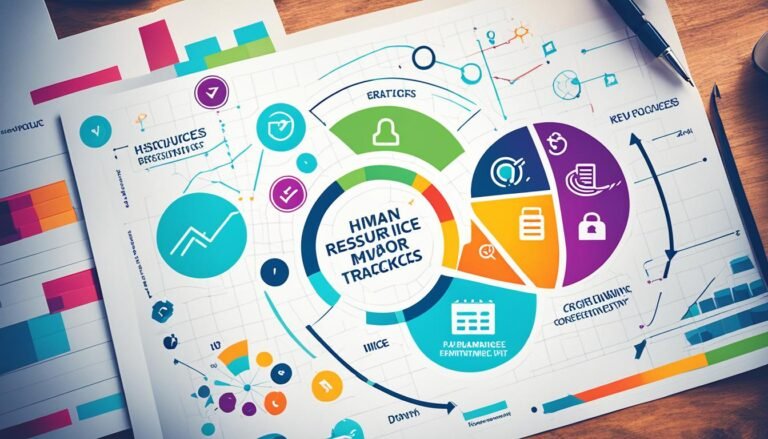A Guide to Human Resource Management Strategic Initiatives
Strategic human resource management (SHRM) is a vital process that organizations use to manage their employees and align HR programs and policies with the company’s business strategy. By creating programs and policies that support the company’s goals, such as performance management, training and development, compensation and benefits, and employee relations, SHRM improves employee performance, develops the workforce, creates a positive work environment, reduces turnover, and enhances productivity.
Key Takeaways:
- Strategic human resource management (SHRM) aligns HR programs with business strategy.
- SHRM focuses on improving employee performance and developing the workforce.
- SHRM creates a positive work environment and reduces turnover.
- SHRM enhances organizational productivity and competitiveness.
- Effective SHRM requires aligning HR programs and policies with business goals.
What Is Strategic Human Resources?
Strategic human resources (SHRM) is an approach that focuses on aligning HR programs and policies with the overall business strategy of a company. Unlike traditional human resources management, which primarily deals with day-to-day employee management, SHRM looks at how employees can contribute to achieving the company’s goals. By actively involving HR in strategic decision-making, SHRM aims to optimize the utilization of human resources to drive organizational success.
Within the realm of strategic human resources, various key areas are addressed to maximize employee performance. These include the development of systems for performance management, identifying and fulfilling employee development needs, designing competitive compensation and benefits programs, and effectively managing employee relations.
SHRM is a proactive and forward-thinking approach that recognizes the importance of human capital in driving business outcomes. It emphasizes the strategic significance of HR programs and policies in contributing to a company’s overall success. By aligning HR practices with the business strategy, SHRM ensures that human resources are utilized efficiently and effectively, enabling organizations to gain a competitive advantage in the marketplace.
Why Strategic Human Resources Is Important
Strategic human resources (HR) play a pivotal role in the success and growth of businesses. By aligning HR programs and policies with the company’s overall business strategy, strategic HR management (SHRM) can have a significant positive impact on various aspects of the organization.
One key area where strategic HR shines is employee performance. Implementing effective HR programs and policies allows organizations to set clear expectations, provide training and development opportunities, and offer incentives that drive employees to excel. This results in improved overall performance and productivity, benefiting both the individual employee and the organization as a whole.
Another crucial aspect of strategic HR is workforce development. SHRM focuses on identifying the skills and knowledge gaps within the organization and designing programs to fill those gaps. By investing in employee development, organizations can build a highly skilled and adaptable workforce, equipped to tackle challenges and seize opportunities in the ever-changing business landscape.
A positive work environment is another key factor attributed to strategic HR. Employers who prioritize creating a positive and inclusive work culture foster high employee morale, engagement, and satisfaction. This, in turn, leads to reduced turnover rates, as employees are more likely to stay with an organization where they feel valued, respected, and motivated to contribute their best.
Reducing turnover is not only essential for employee retention but also for maximizing productivity. When organizations experience high turnover rates, time and resources are wasted on recruitment, onboarding, and training. Strategic HR initiatives, such as implementing effective employee engagement programs, can help create a sense of loyalty and commitment among employees, minimizing turnover and ensuring continuity in operations.
Lastly, strategic HR management directly contributes to overall productivity. By aligning HR programs and policies with the company’s business strategy, SHRM ensures that employees are working towards common goals and objectives. This alignment fosters a culture of collaboration and efficiency, enabling employees to deliver their best work and achieve optimal results.
In conclusion, strategic HR plays a pivotal role in the success and growth of businesses by aligning HR programs and policies with the company’s overall business strategy. Through improved employee performance, workforce development, the creation of a positive work environment, reduced turnover, and increased productivity, strategic HR initiatives contribute to better overall organizational success and help businesses stay competitive in a dynamic business environment.
5 Steps to Strategic Human Resources
Implementing strategic human resources requires careful planning and execution. By following these five steps, businesses can align their HR programs and policies with their company goals and ensure future needs are met.
- Identify Company Goals: Begin by clearly defining the company’s short-term and long-term goals. These goals will serve as the foundation for developing the strategic human resource management (SHRM) plan.
- Create a SHRM Plan: Develop a comprehensive SHRM plan that outlines the specific strategies and initiatives needed to support the company’s goals. This plan should address recruitment and selection, employee development, performance management, compensation and benefits, and employee relations.
- Allocate Resources: Assess the resources required to execute the SHRM plan effectively. This includes evaluating the financial, technological, and human resources needed to implement the initiatives outlined in the plan.
- Execute the Plan: Put the SHRM plan into action by implementing the identified strategies and initiatives. Assign responsibilities, establish timelines, and monitor progress to ensure successful execution.
- Assess and Pivot: Continuously evaluate the effectiveness of the SHRM plan and make necessary adjustments. Monitor key performance indicators and gather feedback from employees to assess the impact of the initiatives. Use this information to pivot and refine the plan as needed.
By following these five steps and continuously assessing and adapting the SHRM plan, businesses can align their human resources with their company goals, fulfill future needs, and optimize their overall workforce performance.
The Benefits of HR Strategic Planning
HR strategic planning provides numerous benefits for organizations. By aligning HR programs and policies with the company’s overall business goals, it enables businesses to address and solve various business problems effectively. This strategic approach ensures that HR initiatives are in line with the organizational strategy, leading to improved employee productivity and performance.
One of the key advantages of HR strategic planning is its ability to align the workforce culture with the organization’s goals. By establishing a strong and cohesive culture that supports the desired business outcomes, HR strategic planning creates an environment where employees are motivated and engaged to work towards the organization’s success.
Furthermore, HR strategic planning provides a clear sense of direction for the entire workforce. It outlines the goals, objectives, and priorities that employees should focus on to achieve organizational success. This clarity of purpose ensures that employees are aligned with the company’s vision and work collectively towards common goals.
Additionally, HR strategic planning plays a crucial role in guiding training and development initiatives within the organization. By identifying the key skills and competencies required to drive business success, HR strategic planning helps in designing and implementing targeted training programs for employees. This ensures that employees have the necessary knowledge and skills to perform their roles effectively.
Employee focus is another significant benefit of HR strategic planning. By clearly communicating the organization’s goals and expectations, HR strategic planning keeps employees focused on achieving those goals. This focus enhances employee engagement and commitment, leading to improved overall performance and productivity.
“HR strategic planning provides a roadmap for organizations to achieve their objectives by aligning HR initiatives with business goals.”
HR strategic planning also addresses critical HR policies such as diversity and inclusion, work-life balance, and talent retention. By incorporating these aspects into the strategic plan, organizations can create a diverse and inclusive work environment, foster work-life balance for employees, and implement effective talent retention strategies.
| Benefits of HR Strategic Planning: |
|---|
| Aligns HR programs with business goals |
| Addresses and solves business problems |
| Aligns workforce culture with organizational goals |
| Improves employee productivity and performance |
| Provides a sense of direction for employees |
| Guides training and development initiatives |
| Keeps employees focused on organizational goals |
| Addresses key HR policies |
The Role of HR in Business Strategy Alignment
HR plays a crucial role in aligning the business strategy with the HR strategy. By bridging the gap between these two essential aspects of an organization, HR professionals are instrumental in driving the success of the company. Through effective communication, strategic planning, and resource management, HR ensures that the HR strategy supports and enhances the overall business strategy.
In order to align the business strategy with the HR strategy, HR professionals work closely with executives to communicate the vision and mission of the company. This involves effectively conveying the goals and objectives of the organization to employees at all levels, ensuring clarity and understanding.
Additionally, HR plays a key role in implementing the core values of the organization into the organizational culture. By promoting an environment that embodies these values, HR fosters a sense of unity and cohesion among employees, aligning their actions and attitudes with the company’s overarching goals.
Furthermore, HR professionals focus employees on key organizational goals, ensuring that everyone is working towards a common objective. This involves providing clear direction and setting achievable targets, empowering employees to contribute to the company’s success.
HR also plays a critical role in promoting commitment, agility, and productivity within the workforce. Through effective talent management strategies, HR ensures that the right people are recruited and retained, matching their skills and capabilities with the needs of the business. By providing training and development opportunities, HR enables employees to enhance their knowledge and skills, keeping them adaptable and responsive in a rapidly changing business landscape.
In addition, HR professionals are responsible for managing employee performance, ensuring that individuals and teams are working effectively to achieve the business strategy. This involves providing feedback, coaching, and support to employees, as well as addressing any performance-related issues promptly and fairly.
Lastly, HR plays a pivotal role in addressing internal challenges that may hinder the alignment between the business strategy and the HR strategy. Whether it’s resolving conflicts, managing change, or fostering a positive work environment, HR professionals are dedicated to creating an atmosphere that enables employees to thrive and contribute to the organization’s success.
In summary, the role of HR in business strategy alignment is multi-faceted and essential. By effectively communicating the company’s vision, implementing core values, focusing employees on key goals, promoting commitment and productivity, and addressing internal challenges, HR ensures that the HR strategy synergizes with the broader business strategy, driving organizational success.
Shaping Organizational Culture in Strategic HRM
Shaping organizational culture is a critical aspect of strategic HRM. A strong culture supports the achievement of business goals by increasing employee engagement, reducing turnover, improving well-being, strengthening brand identity, and fostering innovation.
HR plays a vital role in shaping the desired culture by:
- Defining vision and mission statements to provide a clear direction for the organization.
- Establishing core values that reflect the company’s beliefs and guiding principles.
- Promoting desired behaviors that align with the organization’s values and goals.
- Organizing rituals and routines that reinforce the desired culture and values.
- Creating a favorable climate and atmosphere where employees feel supported and motivated.
- Ensuring appropriate control and power structures that maintain harmony and fairness within the organization.
By focusing on these factors, HR can create a positive and cohesive organizational culture that drives success and supports strategic HRM initiatives.
Case Study: Company X’s Cultural Transformation
“Culture eats strategy for breakfast.” – Peter Drucker
Company X, a well-established tech company, recognized the need to transform its organizational culture to adapt to a rapidly changing market. The HR department took the lead in this transformation journey by defining a new vision and mission focused on customer-centric innovation.
Through a series of workshops and employee engagement initiatives, Company X established core values such as collaboration, agility, and customer obsession. These values were reinforced through daily rituals and routines, such as morning huddles, team-building activities, and recognition programs.
Managers were trained to embody the desired behaviors and lead by example. The HR team created a positive climate by implementing flexible work arrangements, employee well-being programs, and fostering an inclusive and supportive work environment.
As a result of these strategic HRM initiatives, Company X experienced increased employee satisfaction, improved productivity, and a more innovative and adaptable workforce. The cultural transformation played a vital role in the company’s ability to navigate market disruptions, stay ahead of competitors, and drive business growth.”
Shaping organizational culture is an ongoing process that requires continuous effort and commitment. It sets the foundation for strategic HRM initiatives and helps organizations thrive in today’s dynamic business landscape.
The Strategic Human Resource Management Plan
In order to achieve organizational goals, it is essential for businesses to have a well-defined strategic human resource management plan. This plan outlines the HR strategies and tactics that will be implemented to align HR programs and policies with the overall business strategy.
Within the strategic human resource management plan, several key elements are included to address various aspects of HR management. These elements include:
Recruitment Strategies
The plan incorporates recruitment strategies to attract the right talent and ensure a diverse and qualified workforce. By identifying the specific skills and competencies required, HR professionals can devise effective recruitment strategies to fill vacant positions.
Employee Development Plans
Employee development is crucial for enhancing skills, knowledge, and performance. The strategic HRM plan includes detailed employee development plans that outline training programs, mentorship opportunities, and career advancement initiatives to foster employee growth and improve overall organizational capability.
Performance Management Systems
Effective performance management is essential for driving employee productivity and aligning individual goals with organizational objectives. The strategic HRM plan includes the implementation of robust performance management systems that provide regular feedback, set performance targets, and recognize and reward high performers.
Outsourcing Strategies
In some cases, organizations may need to outsource certain functions to optimize efficiency and reduce costs. The strategic HRM plan includes outsourcing strategies that determine which functions can be outsourced, how to manage relationships with external vendors, and how to integrate outsourced activities into the overall HR framework.
Changes in Organizational Structure
As business needs evolve, the strategic HRM plan accounts for changes in the organizational structure. This may involve redefining reporting lines, creating new departments, or implementing cross-functional teams to enhance collaboration and support the achievement of strategic goals.
Succession Planning
Succession planning ensures the availability of talented individuals who can assume critical roles within the organization. The HRM plan includes succession planning strategies to identify and develop future leaders, ensuring a smooth leadership transition and maintaining leadership capacity.
Leadership Capacity Building
Strong leadership is vital for driving organizational success. The strategic HRM plan includes initiatives to build leadership capacity, such as leadership training programs, coaching, and mentorship opportunities to develop the next generation of leaders within the organization.
Reward Systems
Effective reward systems motivate and retain employees. The strategic HRM plan incorporates reward systems that recognize and acknowledge employee contributions, whether through monetary benefits, promotions, or other forms of recognition, fostering a positive and engaged workforce.
Overall, the strategic human resource management plan acts as a roadmap for HR strategies and tactics that support the organization’s overarching goals. It ensures the alignment of human resources to future needs, the development of a desired organizational culture, and the implementation of formal HR policies.
With a well-executed strategic HRM plan in place, organizations can leverage HR strategies to enhance recruitment, employee development, performance management, outsourcing, organizational structure, and leadership capacity.
Challenges of Strategic HRM
Implementing strategic human resource management (HRM) initiatives comes with various challenges that organizations must navigate to achieve success and maintain a competitive edge.
1. Developing Internal Leadership
In strategic HRM, developing internal leadership is crucial for long-term organizational success. It requires identifying high-potential employees, providing leadership development programs, and fostering a culture that promotes leadership growth. Investing in leadership development helps organizations build a pipeline of skilled leaders who can drive change, inspire employees, and achieve business goals.
2. Managing Organizational Change
Strategic HRM often involves managing organizational change and ensuring smooth transitions. HR professionals must effectively communicate change initiatives, address employee concerns, and provide support to individuals and teams as they adapt to new processes and structures. By effectively managing change, organizations can minimize disruption, increase employee engagement, and facilitate the successful implementation of strategic HRM initiatives.
3. Aligning HR with Business Strategy
One of the key challenges in strategic HRM is aligning HR practices with the broader business strategy. HR professionals must have a deep understanding of the organization’s goals and objectives to design HR programs that support and drive strategic outcomes. This involves aligning recruitment and selection processes, performance management systems, training and development initiatives, and reward structures with the organization’s strategic priorities.
4. Addressing Workforce Composition Issues
Strategic HRM requires organizations to address workforce composition issues to ensure they have the right talent in the right roles. This includes identifying skill gaps, implementing effective recruitment and selection strategies, promoting diversity and inclusion, and managing workforce demographics. By addressing workforce composition challenges, organizations can build a diverse and agile workforce that can adapt to changing business needs.
5. Adapting to Changing Labor Market Conditions
Labor market conditions can present challenges for strategic HRM, such as talent shortages, changing job market dynamics, and evolving employee expectations. HR professionals must stay abreast of labor market trends, develop strategies to attract and retain top talent, and create a compelling employee value proposition. Adapting to changing labor market conditions ensures that organizations can effectively compete for talent and maintain a skilled and engaged workforce.
Overcoming these challenges in strategic HRM requires HR professionals to have a deep understanding of business strategy, strong leadership and change management skills, and the ability to adapt HR practices to meet evolving demands. By proactively addressing these challenges, organizations can create a strategic HRM framework that drives employee engagement, supports organizational growth, and achieves sustainable success.
Conclusion
Strategic human resource management initiatives are essential for organizations to thrive in today’s ever-changing business landscape. By aligning HR programs and policies with the company’s overall business strategy, organizations can enhance employee performance, foster workforce development, cultivate a positive work environment, reduce turnover rates, and boost productivity. HR professionals play a pivotal role in shaping the organizational culture, implementing strategic HRM plans, and navigating challenges, paving the way for organizational success and growth.
Through HRM strategic initiatives, businesses can optimize their human capital, ensuring that their workforce is equipped with the necessary skills and knowledge to achieve business objectives. These initiatives create a framework for talent acquisition, retention, and development, as well as performance management, compensation and benefits, and employee engagement. By strategically leveraging HR initiatives, organizations can enhance their competitive advantage and drive business success.
Implementing strategic initiatives in HRM requires a comprehensive approach that involves strategic planning, effective execution, and continuous assessment. HR professionals need to stay proactive in adapting to the evolving needs of the organization and the industry, continuously refining HR strategies and programs to align with changing business priorities. By prioritizing HRM initiatives, organizations can foster a culture of innovation, collaboration, and organizational agility, thereby laying the foundation for long-term growth and success.







